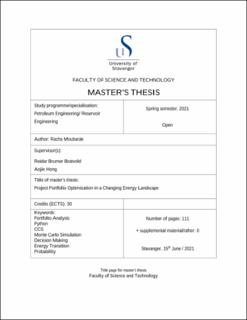| dc.description.abstract | Portfolio analysis and optimization has for the past several decades been applied in the oil & gas
industry for asset allocation with the goal of maximizing corporate value creation. More recently,
the traditional task of deciding between competing petroleum assets has evolved to include CCS
(Carbon Capture and Storage) and renewable energy resource assets due to the change in the
energy landscape. Although oil & gas companies realize that the energy transition is inevitable,
what fossil fuel assets to divest and when to divest them is still open to question as (i) the pace of
the energy transition remains undetermined and (ii) even if oil & gas demand and prices were
predictable, the asset value consequences could vary as acting too slowly could lead to losses
further down the road in addition to reputational problems and acting too quickly could destroy
value for shareholders without contributing to emission reductions.
In this work, we have implemented a multi-objective, time-dependent portfolio model to inform
and support an oil & gas company’s strategic decisions for successfully managing the energy
transition. These decisions include several strategies such as reducing the fraction of the overall
revenues stemming from fossil fuels and increasing ownership in carbon reduction technologies.
The model can easily be extended to include renewable geothermal and solar assets, investments
in blue or green hydrogen or negative emission technologies. Given the high uncertainty in future
supply and demand for both fossil and renewable energy, the optimal portfolio at any point in time
is highly uncertain and must be flexible enough to change over time whilst still meeting the
specified objectives.
The main contribution of the work is a decision framework and model to aid oil & gas companies
in their energy transition efforts. The portfolio optimization and management model has been
developed in Python. It identifies optimal portfolios from a pool of potential petroleum and carbon
reduction projects. These projects include traditional oil & gas producing assets, wind farms and
CCS (Carbon Capture and Storage) assets. Although upstream oil & gas portfolio optimization
methods have been presented in the literature, none of these addresses the carbon reduction
objective and the ability to compare petroleum and non-petroleum assets in a portfolio context.
Hence, the main advantage of this work is that it provides a unified and comprehensive framework
for inclusion of multiple energy related assets in a time-varying and multi-objective portfolio assessment model, with a focus on energy transition and meeting the net-zero carbon emission
ambition of oil & gas companies. | |
